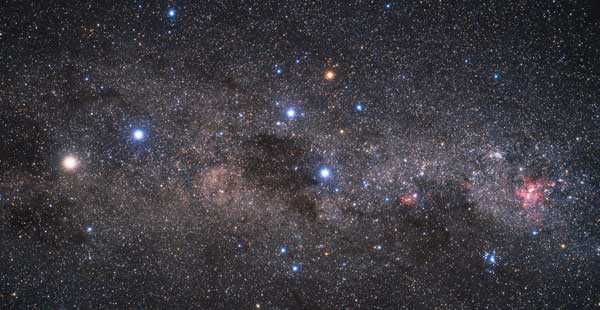Gacrux is a treat for southern observers — the closest red giant to Earth and the tip of the famous Southern Cross.
Gacrux Vitals
| Official name (IAU-approved) | Gacrux |
| Other designations | Gamma Crucis, HIP 61084, HR 4763, HD 108903 |
| Nicknames | Rubidea (in Brazil) |
| Apparent magnitude | 1.64 |
| Distance from Earth | 88.6 light-years |
| Type | Red giant, M3.5III |
| Color | Red/orange |
| Mass | ~1.3 M☉ |
| Radius | ~120 R☉ |
| Constellation | Crux |
| Right ascension | 12h 31m 10s |
| Declination | -57° 06' 48" |
| Multiple system? | No |
| Variable star? | Yes |
| Exoplanets status | None known |
| Probable fate | Planetary nebula/white dwarf |
Physical Characteristics
In this installment of Meet the Stars, we take a trip to the southern skies and examine Gacrux, a red giant star in one of the brightest and beloved asterisms — the Southern Cross.

Akira Fujii
Of the four main stars that make up the Southern Cross, Gacrux is the only red member of the group, a fact that stands out clearly in long-exposure photographs. Its pleasant red color contrasts nicely with the blue-white colors of the other stars in the Cross. The effect is similar to the Betelgeuse’s standout color in Orion (though Gacrux is a much smaller red giant).
Many giant stars are quite distant, often in the range of hundreds or thousands of light-years away from Earth. Gacrux is somewhat unusual in that it’s only about 88 light-years away — the closest red giant to Earth. Gacrux has a diameter 120 times the Sun’s, but it only has about 30% more mass. Like other red giants, Gacrux is huge but fairly diffuse. When the star began using up its fuel reserves, the gas within the star cooled and expanded, a process that will continue as Gacrux advances in its stellar development.
Origin / Mythology
The Southern Cross is a brilliant object, but one that is mostly absent from Western mythology. Though once visible from the Northern Hemisphere, precession, the wobbling progression of Earth’s axis that takes place over thousands of years, slowly shifted the Southern Cross out of view; by around 400 AD it was out of sight and out of mind. (Before it slipped over the horizon, the Greeks considered the Southern Cross stars part of Centaurus.) Europeans rediscovered the Southern Cross by the 1500s. Its modern name is attributed to French cartogropher Augustine Royer, who published maps of the southern sky in 1679, though the constellation appeared in earlier maps too. The name is probably a Christian reference.
Of course, while the Southern Cross was lost from northern view, it remained prominent and important in southern regions, with a wide variety of stories associated with it. The fishing communities in northern Australia, for example, saw the Southern Cross as a stingray, while in the desert regions of central Australia, aboriginals saw in the constellation the track of an eagle. To the Incas, the Southern Cross may have been a “chakana,” (bridge or crossing). A carved stone at Machu Picchu in Peru might represent the Southern Cross.
Today, the Southern Cross appears prominently on the national flags of Australia, New Zealand, Brazil, Papua New Guinea, and Samoa.
The name Gacrux appears to be a contraction of Gamma Crux, from the Latin designation indicating it as the third-brightest star in the constellation. It’s a strictly utilitarian name, like Alpha Centauri.
How to See Gacrux

J. Kelly Beatty / S&T
You must be south of 25°N latitude to see the entire Southern Cross, so it’s virtually impossible to view from the continental U.S. It’s possible to a catch glimpse of Gacrux from the extreme southernmost portions, like the Florida Keys, but catching Gacrux as it briefly pops over the horizon requires a perfectly clear view to the south and precise timing. (Gacrux is the constellation’s northernmost star and therefore the most likely one to see.)
A better plan for viewing the Southern Cross from the U.S. would be a trip to Hawai‘i. The island chain lies just below 25°N, so the constellation is visible in its entirety during winter and spring. Even still, the Southern Cross hangs quite low in the south and only rises for a couple of hours before diving back below the horizon.
For the best views of Gacrux, you’ll need to get into the Southern Hemisphere. (They don’t call it the “Southern Cross” for nothing!) Large portions of South America, Africa, and Australia will show the Cross perfectly, and if you go below 35°S, the Cross becomes circumpolar, staying up all night, just like Cassiopeia does in the north.
There isn’t a convenient south pole star — no Polaris counterpart exists in that portion of the sky — but the Cross can be used as a pointer. An imaginary line from Gacrux through Acrux (the constellation’s southernmost star) points roughly at the celestial south pole.
Seeing Gacrux and the Southern Cross is nothing unusual for citizens of the Southern Hemisphere, but for visitors who have never seen these objects, they can be the highlight of a trip. While you’re there, make sure to check out the Coalsack Nebula within Crux and the Magellanic Clouds (the Milky Way’s miniature companion galaxies) too.
 15
15









Comments
Zubenelgenubi 61
May 27, 2021 at 1:18 pm
That is a little too pessimistic an opinion about Gacrux's visibility. From Sanibel, Florida last month, Gacrux was plainly visible to the unaided eye, about 6-7 degrees above the horizon in spite of only so-so conditions. The two "crossbar" stars of Crux were plain to see in binoculars and showed up well in images. I have able to see them with my unaided eyes from there on rare cloudless, haze-free nights. Alpha and Beta Centauri are in about the same boat as the crossbar stars, but brighter. One time, with binoculars, I was able to discern Acrux, which culminates about 0.4 degrees above the horizon there, plus up to half a degree of refraction. That might be naked eye from Key West under good conditions. Gacrux could possibly be spotted from the latitude of New Orleans or Houston.
You must be logged in to post a comment.
Zubenelgenubi 61
May 28, 2021 at 11:50 am
Latitude was 26°27'.
You must be logged in to post a comment.
Gerald-Hanner
May 27, 2021 at 4:14 pm
You can see all of the Southern Cross standing on Waikiki Beach, but you get a better view if you're on the south end of the Big Island.
You must be logged in to post a comment.
Cousin Ricky
May 27, 2021 at 5:26 pm
> “Though once visible from the Northern Hemisphere, precession, the wobbling progression of Earth’s axis that takes place over thousands of years, slowly shifted the Southern Cross out of view; by around 400 AD it was out of sight and out of mind.”
I live in the Northern Hemisphere (18°N), and I see it every spring. How much of the Northern Hemisphere do you not consider Northern Hemisphere?
You must be logged in to post a comment.
Gerald-Hanner
May 27, 2021 at 6:33 pm
OK. You're someplace in Puerto Rico or Hawaii. You could also be someplace like Guam.
You must be logged in to post a comment.
Cousin Ricky
May 31, 2021 at 5:09 pm
Very close! I’m in the Virgin Islands, just east of Puerto Rico.
You must be logged in to post a comment.
vpk24astro
May 28, 2021 at 1:47 pm
I grew up at 19N and remember enjoying the Southern Cross, Centaurus, and also Canopus every evening. They are but memories now ...
You must be logged in to post a comment.
darkchairman
May 28, 2021 at 8:22 pm
I saw Gacrux at top of Pine Mountain, GA, (El. 1395 Ft.) with binoculars at N32 d. 51m., but could not see it by naked eye. Tom Buchanan
You must be logged in to post a comment.
Daniel_Johnson
May 29, 2021 at 2:04 pm
Nice to see all of the observation experiences!
You must be logged in to post a comment.
Charles Rudolph
May 29, 2021 at 2:32 pm
Back in the mid 1990s while living in Houston (about 30 deg, N.) I could see Gacrux fairly easily from a nearby spot wth a reasonably clear southern horizon. I found it by hopping from Corvus down to the Delta-Omega Centauri pair which point to it. But I cold not see Beta or Delta Centauri. On another occasion I saw all of Crux from Marco Island, FL.
You must be logged in to post a comment.
Charles Rudolph
May 29, 2021 at 2:34 pm
Sorry, I meant I could not see Beta or Delta Crucis.
You must be logged in to post a comment.
Charles Rudolph
May 29, 2021 at 2:44 pm
Again I see I wrote and submitted too fast. It is the pair of Delta and Rho Centauri that point to Gacrux. I was hoping to also see at least Delta Crucis also but never could see that far down.
You must be logged in to post a comment.
Antonnyi
May 29, 2021 at 7:38 pm
And if your latitude permits, check out the carbon star just to the east of Beta Crucis (Mimosa). beautiful
You must be logged in to post a comment.
Andrew James
May 30, 2021 at 5:05 am
Named EsB 365 and lies 340 arcsec in PA 23 deg. from beta
You must be logged in to post a comment.
Wayne Wooten
June 3, 2021 at 1:18 am
It is in fact possible under clear, steady skies to see Gacrux from Pensacola Beach, latitude +30 degrees. My former astronomy student June Hayes proved it to me about 20 years ago with a timed exposure she took of it just above the waves, and we have in fact spotting it on several occasions since. Achernar is another deep south star that can be seen, a little more easily, from the Florida Panhandle, since it is brighter and a little farther north than Gacrux. I suspect for us Gacrux is the most southern star visible with the naked eye from Pensacola.
You must be logged in to post a comment.
You must be logged in to post a comment.